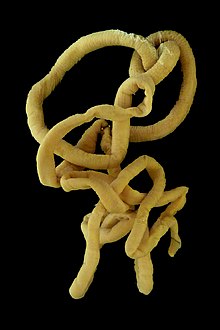Lineus longissimus
| Bootlace worm | |
|---|---|

| |
| Scientific classification | |
| Kingdom: | Animalia |
| Phylum: | Nemertea |
| Class: | Anopla |
| Order: | Heteronemertea |
| Family: | Lineidae |
| Genus: | Lineus |
| Species: | L. longissimus
|
| Binomial name | |
| Lineus longissimus (Gunnerus, 1770)
| |
The bootlace worm (Lineus longissimus) is a species of ribbon worm and one of the longest known animals, with specimens up to 55 m (180 ft) long being reported, although this has not been confirmed.[1] Its mucus is highly toxic.[2]
Taxonomy[]
The bootlace worm is in the phylum Nemertea or ribbon worms. It is the most common nemertean found along the coasts of Britain.[citation needed]
Description[]
Bootlace worms may grow very long but are usually only 5 to 10 millimetres (0.20 to 0.39 in) in width. The body is brown with lighter (longitudinal) stripes.[3] Its mucus contains a relatively strong neurotoxin which it uses as a defense against predators.[citation needed] When handled, it produces large amounts of thick mucus with a faint pungent smell, reminiscent of iron or sewage.[4] This toxic mucus has been shown to kill crabs and cockroaches, and could have applications as an agricultural insecticide.[5]
In 1864 a specimen washed ashore in the aftermath of a severe storm by St Andrews, Scotland, which was more than 55 m (180 ft) long,[6] longer than the longest known Lion's mane jellyfish, the animal which is often considered to be the longest in the world. However, records of extreme length should be taken with caution, because the bodies of nemerteans are flexible and can easily stretch to much more than their usual length.[citation needed]
Like other nemerteans, Lineus longissimus feeds using its eversible proboscis. As it is in the class Anopla, its proboscis is not armed with a barbed stylet. Instead, it has a cluster of sticky filaments at the end of its proboscis that it uses to immobilize prey.[citation needed]
Bootlace worm mucus contains a neurotoxin that is intended to deter predators. It has been shown to be capable of killing crabs and cockroaches, and it has been suggested as a potential agricultural insecticide. The suggestion was made in 2018 by researchers at Uppsala University in Sweden. [7]
Habitat[]
Lineus longissimus can be found on Norway's and Britain's coasts, and also on Sweden's west coast.[citation needed]
References[]
- ^ "Potential insecticide discovered in Earth's longest animal". UQ News. Retrieved 2018-03-30.
- ^ Strand, M., Sundberg, P. 2010. Lineus longissimus Långsnöre, p. 104 – In: Nationalnyckeln till Sveriges flora och fauna. Stjärnmaskar – slemmaskar. Sipuncula – Nemertea. Artdatabanken, SLU, Uppsala, ISBN 978-91-88506-72-6
- ^ "MarLIN – The Marine Life Information Network – Bootlace worm (Lineus longissimus)". www.marlin.ac.uk. Retrieved 2018-03-30.
- ^ Milius, Susan (2018-03-30). "Toxins from the world's longest animal can kill cockroaches". Science News. Retrieved 2018-03-30.
- ^ "Insect toxin detected in the world's longest animal". ScienceDaily. Retrieved 2018-03-30.
- ^ Carwardine, M. 1995. The Guinness Book of Animal Records. Guinness Publishing. p. 232.
- ^ https://www.sciencedaily.com/releases/2018/03/180326140226.htm
External links[]
| Wikispecies has information related to Lineus longissimus. |
| Wikimedia Commons has media related to Lineus longissimus. |
- "Lineus longissimus" at the Encyclopedia of Life
- "Lineus longissimus". National Center for Biotechnology Information (NCBI).
- ITIS
- Lineus longissimus (Gunnerus, 1770) (accepted name) Catalogue of Life: 30 April 2017
- Anopla
- Animals described in 1770
- Taxa named by Johan Ernst Gunnerus